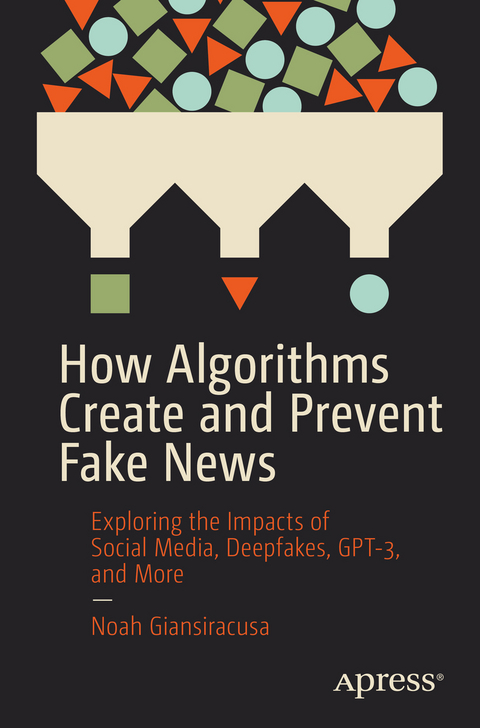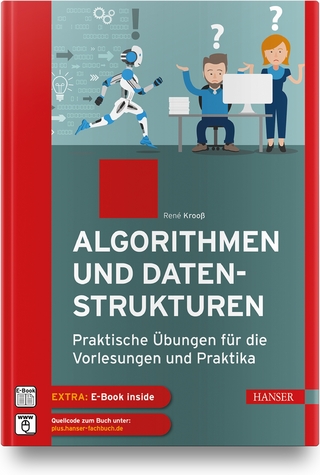
How Algorithms Create and Prevent Fake News
Apress (Verlag)
978-1-4842-7154-4 (ISBN)
---Paul Romer, Nobel Laureate, University Professor in Economics at NYU, and former Chief Economist at the World Bank.
“By explaining the flaws and foibles of everything from Google search to QAnon—and by providing level-headed evaluations of efforts to fix them—Noah Giansiracusa offers the perfect starting point for anyone entering the maze of modern digital media.”
—Jonathan Rauch, senior fellow at the Brookings Institute and contributing editor of The Atlantic
From deepfakes to GPT-3, deep learning is now powering a new assault on our ability to tell what’s real and what’s not, bringing a whole new algorithmic side to fake news. On the other hand, remarkable methods are being developed to help automate fact-checking and the detection of fake news and doctored media. Success in the modern business world requires you to understand these algorithmic currents, and to recognize the strengths, limits, and impacts of deep learning---especially when it comes to discerning the truth and differentiating fact from fiction.
This book tells the stories of this algorithmic battle for the truth and how it impacts individuals and society at large. In doing so, it weaves together the human stories and what’s at stake here, a simplified technical background on how these algorithms work, and an accessible survey of the research literature exploring these various topics.
How Algorithms Create and Prevent Fake News is an accessible, broad account of the various ways that data-driven algorithms have been distorting reality and rendering the truth harder to grasp. From news aggregators to Google searches to YouTube recommendations to Facebook news feeds, the way we obtain information todayis filtered through the lens of tech giant algorithms. The way data is collected, labelled, and stored has a big impact on the machine learning algorithms that are trained on it, and this is a main source of algorithmic bias – which gets amplified in harmful data feedback loops. Don’t be afraid: with this book you’ll see the remedies and technical solutions that are being applied to oppose these harmful trends. There is hope.
What You Will Learn
The ways that data labeling and storage impact machine learning and how feedback loops can occur
The history and inner-workings of YouTube’s recommendation algorithm
The state-of-the-art capabilities of AI-powered text generation (GPT-3) and video synthesis/doctoring (deepfakes) and how these technologies have been used so far
The algorithmic tools available to help with automated fact-checking and truth-detection
Who This Book is For
People who don’t have a technical background (in data, computers, etc.) but who would like to learn how algorithms impact society; business leaders who want to know the powers and perils of relying on artificial intelligence. A secondary audience is people with a technical background who want to explore the larger social and societal impact of their work.
Noah Giansiracusa received a PhD in mathematics from Brown University and is an Assistant Professor of Mathematics and Data Science at Bentley University, a business school near Boston. He previously taught at U.C. Berkeley, University of Georgia, and Swarthmore College. He has dozens of publications in math and data science and has taught courses ranging from a first-year seminar on quantitative literacy to graduate machine learning. Most recently, he created an interdisciplinary seminar on truth and lies in data that was the impetus for this book. He has received national grants and spoken at international conferences for his research in mathematics, and he has been quoted several times in Forbes as an expert on artificial intelligence. Noah also created a high school outreach program for underrepresented and disadvantaged youths, focusing on mathematics and statistics in the courtroom, that was headlined by an Obama-appointed Federal Circuit judge.
1. Perils of Pageview.- 2. Crafted by Computer.- 3. Deepfake Deception.- 4. Autoplay the Autocrats.- 5. Prevarication and the Polygraph.- 6. Gravitating to Google.- 7. Avarice of Advertising.- 8. Social Spread.- 9. Tools for Truth.
“The book requires no technical background and is widely accessible. The narrative is compelling, with good use of historical and contemporary examples … . The exposition hits a sweet spot – precise and thorough, yet brisk and not overly technical – that could make for some excellent supplemental reading … . This book succeeds in its objective and is an easy recommendation for anyone looking to understand these issues at a deeper level than we find in the popular media.” (Bill Wood, MAA Reviews, January 10, 2022)
| Erscheinungsdatum | 23.07.2021 |
|---|---|
| Zusatzinfo | 2 Illustrations, black and white; XII, 235 p. 2 illus. |
| Verlagsort | Berkley |
| Sprache | englisch |
| Maße | 155 x 235 mm |
| Themenwelt | Geisteswissenschaften ► Philosophie ► Ethik |
| Informatik ► Theorie / Studium ► Algorithmen | |
| Informatik ► Theorie / Studium ► Künstliche Intelligenz / Robotik | |
| Mathematik / Informatik ► Mathematik ► Analysis | |
| Mathematik / Informatik ► Mathematik ► Wahrscheinlichkeit / Kombinatorik | |
| Schlagworte | algorithmic bias • Artificial Intelligence • Autocomplete • Deepfakes • Deep learning • Fact-check • Fake News • Polygraph • recommendation algorithms • tech giants • text generation • youtube |
| ISBN-10 | 1-4842-7154-8 / 1484271548 |
| ISBN-13 | 978-1-4842-7154-4 / 9781484271544 |
| Zustand | Neuware |
| Haben Sie eine Frage zum Produkt? |
aus dem Bereich


